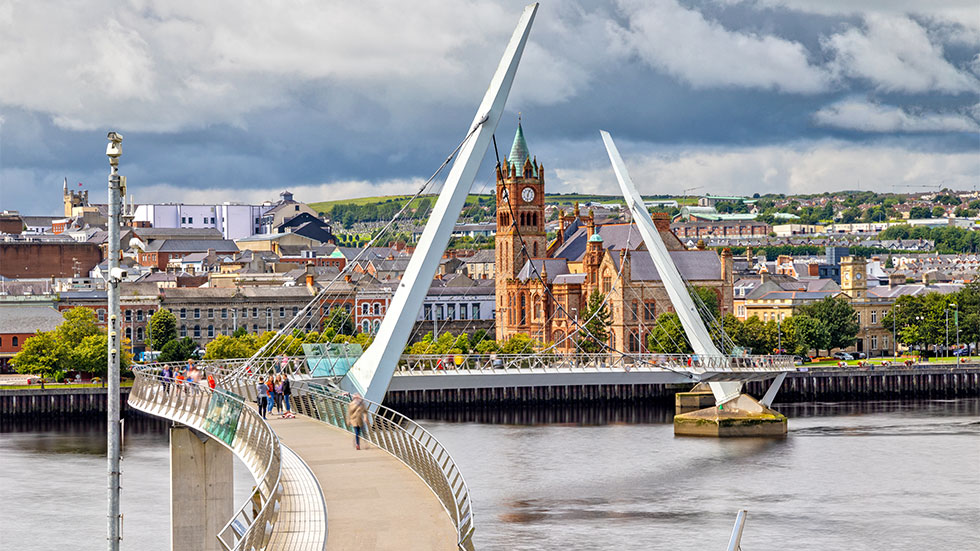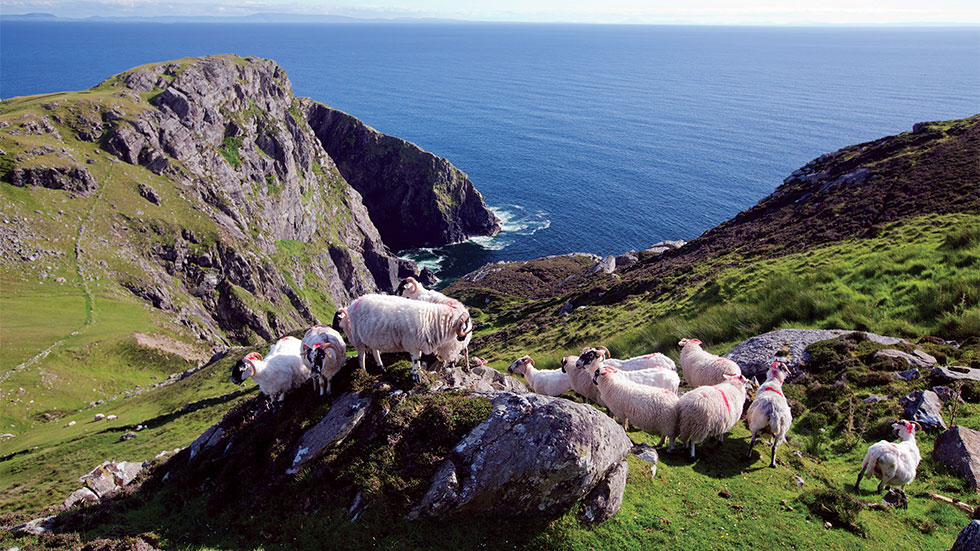Inside Ireland’s Good Times and Traditional Tunes
A lover of Irish music finds camaraderie and craic in trad sessions across the north of Ireland

Sloping down from ancient walls, Waterloo Street in Derry (Londonderry), Northern Ireland, is lined with pubs. But my friend Clare and I weren’t after just any pub; we were looking for a trad session, those distinctively Irish happenings when musicians gather in pubs to play traditional Irish tunes. More than halfway down the cobbled street, we found it. Snug with plush seating and a portrait of Ireland’s Nobel laureate poet, Seamus Heaney, on the wall, An Beár Beag has an air of sophistication.
Cocktails in hand, we settled into upholstered chairs as three musicians played—fewer than the 10 or 15 who often show up on trad nights, but that was fine. Then came a bonus: A woman, clearly a trained dancer, left her seat, spoke briefly with the musicians and took to the floor, stepping and spinning to a spirited tune. Soon, she was gone, but Clare and I stayed on. You never know what a trad session will bring.
 A symbol of hope, the Peace Bridge in Derry; Photo by juriah mosin/stock.adobe.com
A symbol of hope, the Peace Bridge in Derry; Photo by juriah mosin/stock.adobe.com
WHERE THE MUSIC PLAYS
The reels, jigs and ballads of traditional Irish music spill out of pubs in modern cities and villages forgotten by mapmakers. Sometimes haunting, mostly joyful, traditional tunes evoke the beauty and bleakness of Ireland, shifting from uplifting to heartbreaking in an instant. While there’s rarely dancing and only occasional ballads, toe-tapping, clapping, drinking and talking are always in play. These aren’t performances. At their heart, camaraderie and the love of craic—Irish for a good time—are as fundamental to sessions as the music itself.
It was trad sessions that drew me to Ireland in July 2022. Irish friends Clare and her husband, Dermot, were my guides, with music being the connecting thread of our journey across Northern Ireland to the wilds of County Donegal in the Republic of Ireland and back. Our itinerary followed no particular route—everywhere we visited is within three hours of the others, most within an hour. Instead, we went where the music was, on nights trad sessions were scheduled. Around each pub, we found much to see and do.
Derry melds history and heritage with diverse attractions. In addition to pub adventures, we walked the hope-inspiring Peace Bridge and delved deep into the city’s past at Tower Museum. But it’s the powerful Free Derry Museum that stays with me, its visceral accounting of Bloody Sunday wrenching and incomprehensible.
Less than an hour away from Derry, Crosskeys Inn is Ireland’s oldest thatched-roofed pub. Opened in 1654 in a quiet corner of County Antrim, its warren of low-ceilinged rooms with weathered beams and worn stone floors feels like a portal to the past. Trad sessions typically include a fiddle (or three), Irish flutes, tin whistles, uilleann pipes and bodhrán drums, a notoriously hard-to-play Celtic instrument pre-dating Christianity. At Crosskeys, a harpist joined in, providing a melodic addition.
Nearby, I indulged my love of literature. Seamus Heaney HomePlace, an arts and literary center in Bellaghy, celebrates the poet and the landscape he grew up in. Outside the center, Clare and I followed the boardwalk across the flower-filled, marshy landscape Heaney wrote about so eloquently.
 Blackface sheep grazing on the cliffs of Sliabh Liag; Courtesy tourism Ireland
Blackface sheep grazing on the cliffs of Sliabh Liag; Courtesy tourism Ireland
DISCOVERING DONEGAL
Little marked the border between Northern Ireland and Ireland on our drive to Donegal, except that the road signs were suddenly in Irish. Ireland’s northernmost county, Donegal feels as if it had dug into the peat to stay resolutely behind the modern world. We spent four nights at a whitewashed cottage with views past wildflowers and black-faced sheep to conical Mount Errigal. It was there in Gaoth Dobhair, a stretch of Gaeltacht Donegal cradled between Mount Errigal and the sea, that I encountered the unbending rules of trad.
At Bunbeg, the coast folds into undulating grassy dunes and broad swaths of sand. We moseyed past afternoon beach walkers to inspect the skeleton of a fishing-boat-turned-tourist-attraction made famous by photographers chronicling its inexorable disintegration since 1977.
Just before 10 p.m., we entered the dim interior of Teach Hiúdaí Beag, a pub devoted to keeping trad music flourishing. A crowd of cheerful strangers filled the place until tables became shared space and the dimness seemed to lift with the first lilting notes. Owner Hugh Gallagher alternated between keyboard and fiddle, joining the group of locals and visitors.
One young woman from elsewhere played a lovely fiddle solo, but I soon learned it was all wrong. Outside on a break, the visibly upset Gallagher told me why—it wasn’t trad, an unpardonable sin on trad night. My favorite Donegal pub lies north, near Downings. Dark and squat with a faint scent of centuries-old whiskey and ale hanging in the air, Olde Glen Bar dates to 1768. The circle of four to 10 players ebbed and flowed as musicians came and went, some young, some old, all welcomed. Olde Glen’s patrons mostly sipped pints and talked quietly, a nice change from more raucous pubs.
 The Rusty Mackerel at the foot of Sliabh Liag offers warmth, whiskey, food and music; Photo courtesy of The Rusty Mackerel
The Rusty Mackerel at the foot of Sliabh Liag offers warmth, whiskey, food and music; Photo courtesy of The Rusty Mackerel
Every inch of Donegal is worth exploring, starting with the northern stretch of the 1,600-mile-long Wild Atlantic Way, which skirts Donegal’s rugged coast before disappearing south to County Cork. The route winds atop daunting cliffs, deep bays and boulder-strewn shores far below. I wisely left the navigating to Clare and Dermot while I reveled in sweeping panoramas. In southwest Donegal, Sliabh Liag is a must-stop off the Wild Atlantic Way. Often wrapped in creeping fog and slashed with rain, the nearly 2,000-foot sea cliffs beckon visitors anyway, weather be damned. We followed the relatively easy path from the lower carpark to the lookout, mostly bent against rain and chilling wind. The sky brightened briefly at times for photos, but none accurately captured the profound beauty of Sliabh Liag. At the foot of Sliabh Liag, The Rusty Mackerel offers traditional music and cozy respite.
An hour inland from Bunbeg, Glenveagh National Park encompasses an evocative terrain of mountains, lakes and glens, not to mention a castle and lush gardens recalling Victorian romanticism. It was there that we spent our time, among the startlingly vivid peonies and roses. Part of Mount Errigal lies within the park, but the trailhead for Donegal’s highest peak is outside it. With bridges, gullies, mud, scree and a trickling stream, the first section of trail is a moderate climb, doable even for inexperienced hikers. We turned back midway, leaving the summit climb for serious ones.
 Fiddle player at a session in Madden’s Bar, Belfast; Photo by Christine Loomi
Fiddle player at a session in Madden’s Bar, Belfast; Photo by Christine Loomi
FOR THE LOVE OF CRAIC
Back across the border, Belfast is defined neither by contemporary culture nor volatile history. While walls still divide some Catholic and Protestant neighborhoods and tensions are palpable at times, Belfast is a vibrant city with much for visitors. We overnighted at Harrison Chambers of Distinction, a fanciful boutique hotel in a landmark Victorian residence in the city’s leafy Queen’s Quarter, and chose Madden’s Bar for our trad session, a good-old pub where patrons philosophize in that drink-induced way and music is the backdrop to laughter and a cacophony
of conversations.
It’s hard to overstate the importance of community and camaraderie to trad sessions. Young musicians learn from experienced ones and are always welcomed. Clare and Dermot’s daughter, Róise, is a gifted musician, and though her fiddle sat beside her at Madden’s, she wouldn’t join in. One young musician kept encouraging her, until she finally relented. Her fiddle notes rose and fell with the others, and it was one of the sessions I liked most because it epitomized everything trad sessions can be: joyful, eclectic, and crowded with patrons of all ages and types.
When the music plays, no one cares who you are or what you believe in. It’s craic—and plenty of pints to keep it going.
